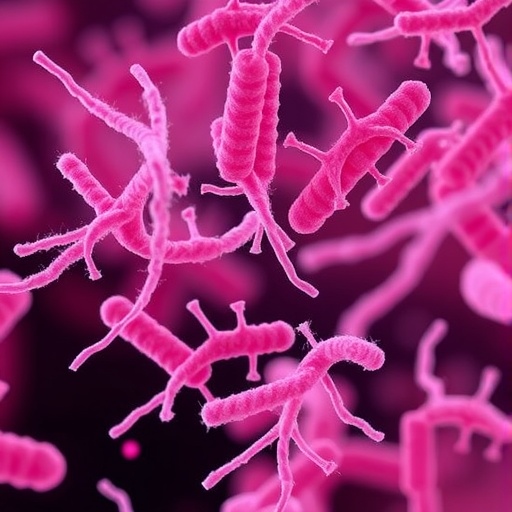In an era where understanding the genetic basis of organisms has become crucial for both ecological and agricultural advancements, a remarkable study has surfaced from the realm of entomopathogenic bacteria. This research, freshly published in the esteemed journal BMC Genomics, delves into the intricate genetic architecture of resistance mechanisms against plant secondary metabolites in the genus Photorhabdus. The investigation surfaces from a collaborative effort led by scholars A. Boss, S. Toepfer, and M. Erb, among others, illuminating the evolutionary adaptations that these fascinating bacteria have developed in response to plant defenses.
Entomopathogenic bacteria like Photorhabdus are extraordinary in their ability to infect and kill insect hosts. This makes them significant not only for understanding microbial pathogenesis but also for potential applications in biocontrol of pest species. Their natural occurrence in the insect host, coupled with their ability to produce a variety of secondary metabolites, positions these bacteria at the forefront of biological research in plant-insect interactions. In essence, through this groundbreaking study, researchers are unveiling how these bacteria have evolved to survive in an environment filled with toxic challenges posed by plants.
In the international scientific community, there has been a growing interest in how microbial life can act as a formidable opponent to insects that are often viewed as agricultural pests. By illuminating the genetic underpinnings of resistance mechanisms in Photorhabdus, the study sheds light on biological pathways that have evolved over millions of years. Thus, the implications of this research extend beyond academic curiosity; they venture into practical applications in pest management and sustainable agriculture.
One of the core findings of the investigation was that the resistance to plant secondary metabolites is not just a single trait but involves a complex web of genetic interactions. Researchers discovered that multiple genes are implicated in this resistance, each contributing in varying degrees to the overall defensive capability of the bacteria. This multi-gene involvement suggests that the evolution of resistance is a dynamic process, honed by natural selection as the bacteria encounter different plant species and their associated chemical defences.
Moreover, the researchers employed advanced genomic techniques to unravel the genetic architecture governing these resistance mechanisms. Through comprehensive genome sequencing and analysis, they identified specific alleles associated with increased resistance. What stands out is the identification of particular gene clusters that participate in metabolite catabolism—allowing Photorhabdus to neutralize toxic compounds produced by plants. This genomic insight not only adds to our understanding of microbial behavior but also opens new avenues for biotechnological exploitation.
The evolution of resistance mechanisms in response to plant secondary metabolites serves as a significant case study in evolutionary biology. It provides a clear example of how living organisms can adapt their biochemical pathways over time. The ability of Photorhabdus bacteria to withstand poisonous plant defenders points to a co-evolutionary arms race, where plants themselves have developed intricate chemical defenses to thwart potential herbivores, which consequently drives bacteria like Photorhabdus to innovate in terms of their survival strategies.
Furthermore, the comprehensive study also raised intriguing questions related to gene regulation. The researchers discovered that the expression levels of specific genes involved in resistance vary depending on environmental cues and stress conditions. This regulation might be a crucial factor in determining how effectively Photorhabdus can adapt to diverse ecological niches. Such nuances in gene expression emphasize the sophistication of microbial life and their remarkable capacity to respond to changing environmental landscapes.
Beyond implications for pest management, the findings of this research highlight important considerations within the framework of ecological balance. Understanding how entomopathogenic bacteria operate could offer insights that benefit agricultural productivity without exacerbating problems associated with chemical pesticides. Instead, harnessing the natural resistance mechanisms found in bacteria like Photorhabdus could lead the charge towards integrated pest management strategies that are less harmful to ecosystems.
While the current study focuses on the resistance to plant metabolites, the broader context of Photorhabdus biology opens avenues for further research into their metabolic pathways. There is much to learn about how these bacteria synthesize various compounds, and their potential utility in pharmaceuticals or even bioremediation efforts cannot be overlooked. By dissecting their genetic makeup, we not only recognize their role as natural pest controllers but also their value in technological applications.
As we progress into a future threatened by food security and biodiversity loss, investigations like this one remind us of the profound interconnectedness of life. The story of Photorhabdus and its fight against plant defenses is one of adaptability and resilience. Through comprehensive research, we gain tools not only to sustainably manage pests but also to appreciate the evolutionary narratives that shape biological diversity.
In conclusion, the genetic architecture of resistance to plant secondary metabolites elucidated in this study offers a pivotal reference point for future studies aimed at bridging microbial genetics with ecological applications. As the research community continues to explore the implications of these findings, there is immense potential to reshape our understanding of biological resistance and its applications. This research serves as a beacon of hope, paving the way for innovations in pest management and sustainable agricultural practices.
The revelations outlined in this study not only contribute to our scientific knowledge but also inspire a future where we can work in tandem with nature to enrich agricultural systems. The time has arrived for profound shifts in our approach, and the journey toward harnessing the power of Photorhabdus has only just begun.
Subject of Research: Genetic architecture of resistance to plant secondary metabolites in Photorhabdus entomopathogenic bacteria.
Article Title: Genetic architecture of resistance to plant secondary metabolites in Photorhabdus entomopathogenic bacteria.
Article References:
Boss, A., Toepfer, S., Erb, M. et al. Genetic architecture of resistance to plant secondary metabolites in Photorhabdus entomopathogenic bacteria.
BMC Genomics 26, 975 (2025). https://doi.org/10.1186/s12864-025-12067-x
Image Credits: AI Generated
DOI: 10.1186/s12864-025-12067-x
Keywords: Photorhabdus, entomopathogenic bacteria, genetic architecture, plant secondary metabolites, resistance mechanisms, ecological interactions, biocontrol, sustainable agriculture.




